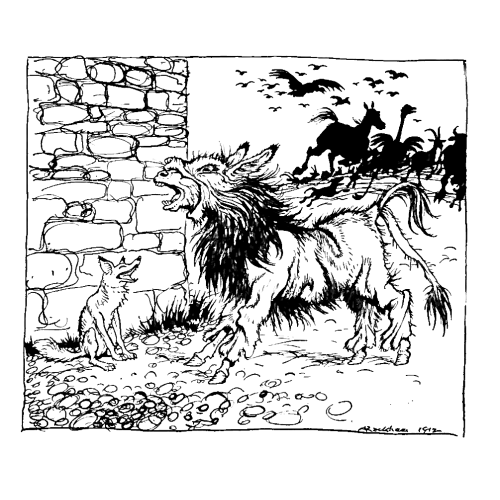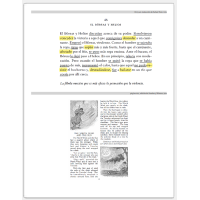Charlotte Mason suggested fables.
In 2023, we made a brand, new edition for our Spanish students.

La Æsopica Para Niños
adapted by late y llama, 2023
This edition, by late y llama, has three simplified versions of Aesop’s Fables from a popular book written by Valdemar Edward Paulsen and illustrated by Milo Winter. These "tiered" versions are followed by a translation into Spanish by various authors, including Julia Sabaté Font and Félix María Samaniego.
Tiered versions gently guide readers, starting with simplicity and building step by step to the full richness of the original text.
Estos textos están escritos en grada; empiezan simple hasta alcanzar el texto auténtico.
Pages referenced here are as appear in The Aesop for Children, often referred to as "Winter's Aesop", written by Valdemar Edward Paulsen and illustrated by Milo Winter. The 1919 version was published by Rand McNally, and it seems that many homeschooling families have the 1993 Barnes & Noble / Checkerboard reprint.
- The Wolf and the Kid, page 11 (El cabrito y el lobo flautista)
- The Tortoise and the Ducks, page 12
- The Dog, the Cock, and the Fox, page 14
- Belling the Cat, page 15
- The Boy and the Filberts, page 16
- The Town Mouse and the Country Mouse, page 18
- The Fox and the Grapes, page 20
- The Ass and His Driver, page 22
- The Lion and the Mouse, page 23
- The Shepherd Boy and the Wolf, page 24
- The Oak and the Reeds, page 32
- The Boys and the Frog, page 34
- The Crow and the Pitcher, page 34
- The Ants and the Grasshopper, page 34
- The Ants and the Grasshopper, page 34
- The Raven and a Swan, page 35
- The Two Goats, page 36
- The Fox and the Stork, page 44
- The Fox and the Lion, page 49
- The Farmer and His Sons, page 65
- The Goose and the Golden Egg, page 66
- The Wolf in Sheep’s Clothing, page 75
- The Wolf and the House Dog, page 82
- The Hare and the Tortoise, page 96
- The Dog and His Reflection, page 96
- The Fox and the Crow, page 101
- The North Wind and the Sun, page 109
- The Ass in the Lion’s Skin, page 111
one fable: "The Lion and the Mouse"
- Tier 1 is repetitive and simple.
- Tiers 2 and 3 grow in complexity.
- an original, authentic Spanish translation is the goal
- and the familiar 1919 Winters Paulsen version completes the support in English
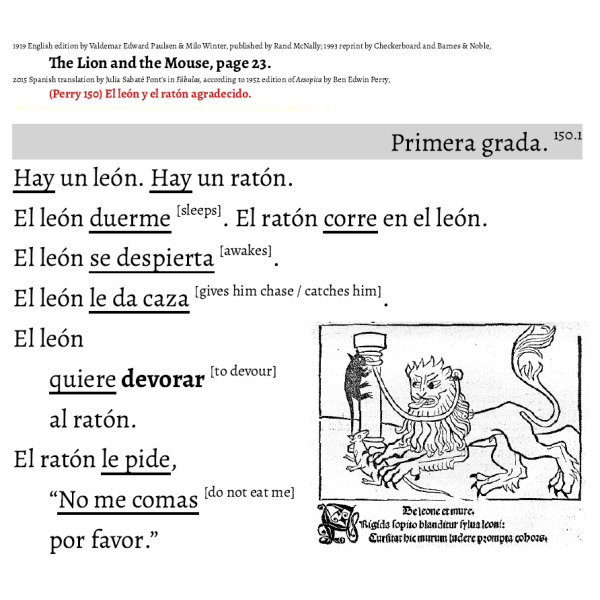


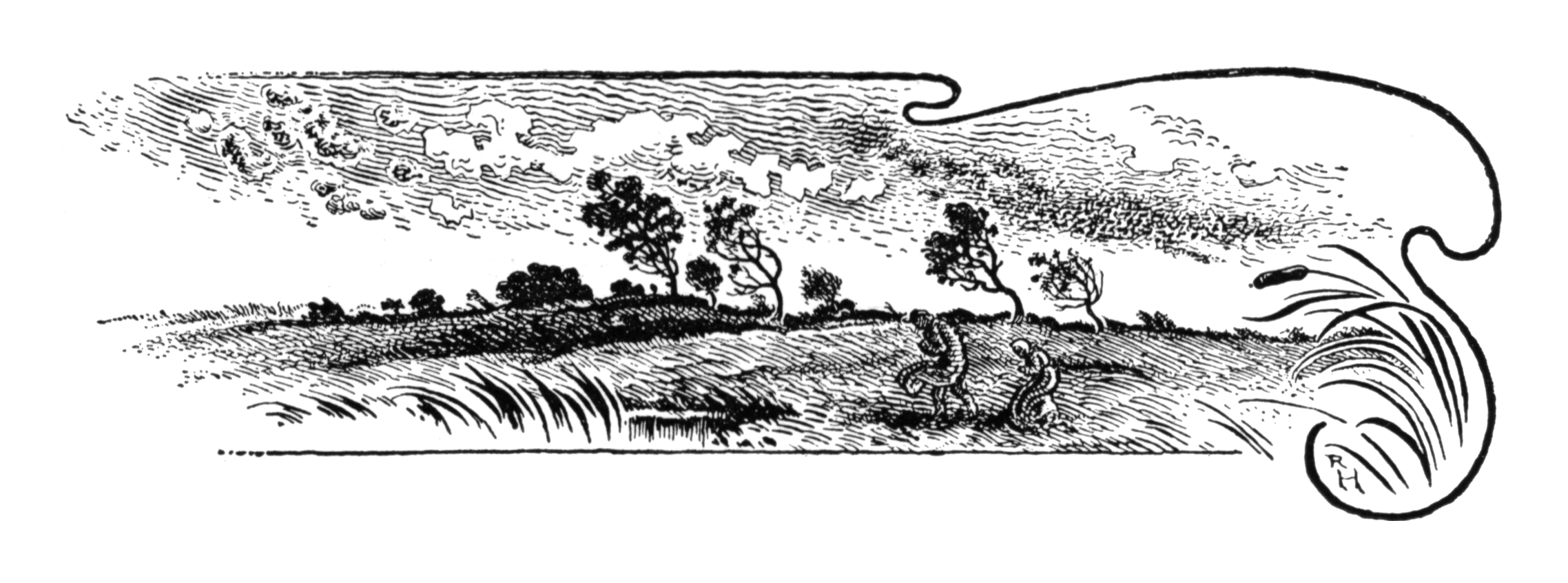
This is how I found my way back
Many of us who now homeschool often find ourselves discovering what we’ve lost. I have read Aesop’s Fables countless times. Yet in my two decades in the public school literature classroom, I had never taught them in any significant way. It was in our Charlotte Mason homeschool setting that I found Aesop again. I'm a bit haunted and I ask myself, "Why didn't you share the fables with your students?" With a new-found energy, I have found these versions very useful in the Spanish-language classroom in my traditional school. And of course, there was no doubt that these fables would be VERY useful in a homeschool setting.
May these Fables find their way into the hearts of many students.
Useful links:
- Paulsen & Winters (1919) English: here, and here and here
- Sabaté Font (2005) Spanish: purchase her translation here
- Samaniego (1781) Spanish: here
- Ambleside Online: here
(it is our goal to offer the entire Ambleside selection)
introduction to this edition (2023)
Many of us who now homeschool often find ourselves discovering what we’ve lost. I have read Aesop’s Fables countless times. Yet in my two decades in the public school literature classroom, I had never taught them in any significant way. It was in our Charlotte Mason homeschool setting that I found Aesop again.
Two events brought Aesop foremost to my mind. First, I encountered The Fables in my Spanish literature course. In the middle ages, during the transition from Latin to Castillian Spanish, some of the only texts that survive in that early vernacular are translations or adaptations of Aesop’s Fables. When I encountered these texts, I brought them to my high school literature students to highlight how medieval culture valued these “moralizing narratives”. I show my students the power that talking animals have not only in teaching moral lessons, but in bringing mirth to readers. (Imagine my surprise when I further discover that there were indigenous translations of Aesop, from the Latin and Greek into ancient nahuatl, the language of the Mexica (Aztec) of Mesoamerica.)
Second is an encounter with a scene that is typical of many homeschooling families: one of my children curled up with the 1919 edition of The Aesop for Children.
How have I missed sharing this with my students? Now I know that as a Spanish teacher, my students and I have access to so many different versions of the fables. But like so many old, school things, they are something of value that have been lost in modern education. Why doesn’t anyone share these things?
Here is our attempt.
This edition has three simplified versions of Aesop’s Fables from a popular adaptation written by Valdemar Edward Paulsen and illustrated by Milo Winter. The 1919 version was published by Rand McNally, and it seems that many homeschooling families have the 1993 reprint Barnes & Noble / Checkerboard.
This volume selects the fables recommended by the homeschool curricula of the Charlotte Mason Educational Center (the CMEC) and the Charlote Mason Institute’s The Alveary. Both appear to have Ambleside Online’s selections as inspiration.
This edition also includes a few favorites to academia late y llama staff.
The Spanish texts were created with a tiered by late y llama to accompany the 2015 Spanish translation by Julia Sabaté Font’s in Fábulas. They are “tiered” step by step (en grada), so we start with easier and more simple texts and work our way up to the authentic Spanish translation. Like Sabaté Font, we label our fables according to 1952 edition of Aesopica by Ben Edwin Perry. We (plan to) include concordance to another Fable organization system, by Francisco Rodríguez Adrados in Historia de la fábula greco-latina, vol. iii.
Discovering the Spanish fabulist Rodriguez Adrados (1922-2020) was a wonderful personal discovery. He was a Classicist who loved education and defended it. To give you an idea of who he was, his memoirs were entitled, Defendiendo la enseñanza de los clásicos griegos y latinos. Casi unas memorias. (Defending the teaching of the Greek and Latin classics. Almost a memoir.)
I would have liked to ask him many questions, I have no doubt that he and Charlotte Mason would have shared a lot in common. May these Fables find their way into the hearts of many students.
editor, José F. Moreno for academia late y llama, 2023
take a peek inside
high quality pdf will be available here
fables in this edition
students have more fables with our Moodle website
We are proud to share that students in our program have access to a dedicated Moodle website! Dive deeper into the world of Aesop’s Fables with an enriched experience that includes:
- Audio: Listen to narrated versions of the fables, perfect for auditory learners or those who enjoy storytelling.
- Text: Access the full text of the fables, including tiered Spanish translations for a step-by-step learning experience.
- Images: Enjoy beautifully curated illustrations, including selections from classic editions.
- Additional Fables: Discover even more examples of fables, beyond the featured selections, to expand your understanding and appreciation of this timeless genre.
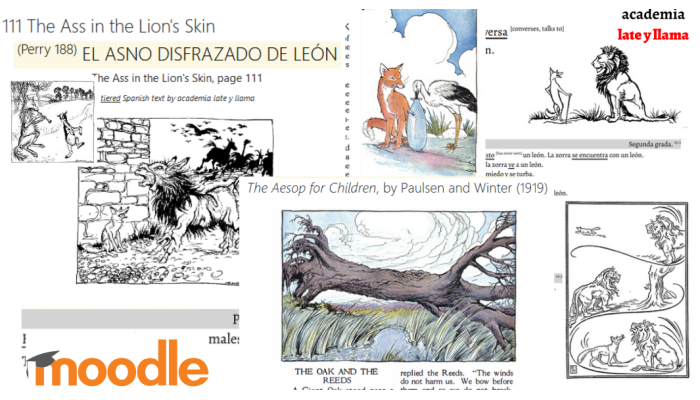
Our Moodle platform is designed to enhance student learning journey with engaging multimedia and comprehensive resources. Students have 24/7 access to our Moodle site where they can immerse themselves in the rich legacy of Aesop’s Fables, in Spanish!
